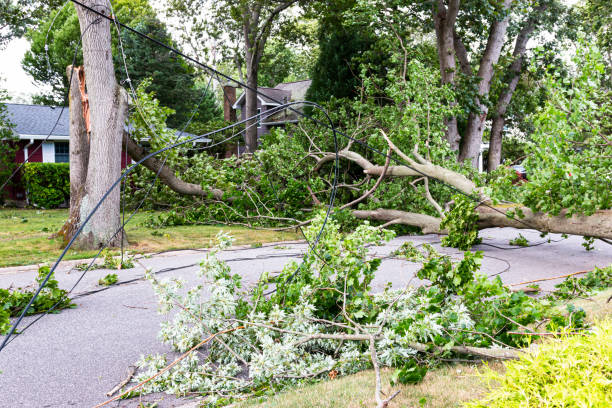
Homeowners can easily become injured – often fatally – while attempting to trim trees near overhead electrical wires. Though it is tempting to try to save money with this “do-it-yourself” approach, the potential for electrocution is not worth the risk.
Terrible accidents can happen when a homeowner uses pole-mounted cutting tools and/or metal ladders when attempting to trim backyard trees and shrubs. Too often, an energized overhead wire is not noticed and is touched by pruning tools, causing injury or death. Examples include:
- A Florida resident was hospitalized after attempting to cut palm branches while standing on a ladder. One of the branches made contact with a power line and severely shocked the man. The local fire department had responded to four similar incidents during the previous year.
- A homeowner climbed a ladder to trim a tree branch that was dropping leaves into his above-ground swimming pool and causing a nuisance. A branch came in contact with the power line, shocking the man with a jolt of electricity and sending him into cardiac arrest. He fell 20 feet to the ground but was revived by medics at the scene.
- One Florida man was killed and another was seriously injured after being shocked by transmission lines while trimming trees. The homeowner was cutting down a tree when it fell directly onto a transmission line. He was pronounced dead on the scene. A Good Samaritan who tried to help the victim was shocked and burned through the energized ground around the victim.
These are not freak accidents; they are preventable.
Tree limbs can conduct electricity. When trees grow near overhead electrical wires, they can contact the wires and become energized. Trees and wires are dangerous, full of electrical power that can injure or kill humans.
There are several things that can go wrong for do-it-yourselfers trying to trim tree branches. For example, if proper tree cutting techniques are not understood, the cut branch can swing in unpredictable directions as it falls and could easily land on an energized wire.
Don’t be fooled by the voltage of the lines. You may think that working on the trees or shrubs near your home’s service line is safer than working near the high voltage secondary distribution lines on the pole by the street, but that’s simply not true.
There are three-wire (called “triplex”) lines connecting the power lines on the pole to your house (meter). Service wires leading from the pole to the house can pack a punch. The type of shock you might have received (and survived) when changing a household light switch is not the same type of shock you will receive if you contact a low-voltage utility wire.
A common house switch carries 120 volts but the electric flow is usually limited to 10, 15 or 20 amps. A common “house drop” (service wire) contains 240 volts and up to 20 amps or more. Given the right set of circumstances, even the shock a person gets from a common light switch can kill, but at the same time, it is easier to break electrical contact while standing inside a house. If a person is climbing a ladder or is in the tree, it may be more difficult to break contact with the energized wire. This means that the service line over a typical yard could easily kill a person.
Here are a few tips to avoid trees in wires:
- Look for power lines before pruning trees and large shrubs. If lines are anywhere near the tree, don’t attempt any tree work. Professional tree climbers have the training and equipment needed to perform these tasks safely.
- Never climb a tree in order to prune it. Even if the wires aren’t currently touching the tree, remember that the tree’s branches will shift once you begin climbing or removing limbs.
- Wearing rubber-soled shoes or rubber gloves while tree pruning will not prevent a fatal shock.
- Never extend long-handled saws or pruners into a tree without checking for power lines. Electricity is always trying to go somewhere, and it will easily travel through metal, water, trees, and/or the ground.
- Don’t move ladders or long-handled pruning tools around the yard without first looking up. Always read and heed ladder-use safety labels.
More importantly, hire an insured, tree care professional with the experience, expertise and equipment to safely take down or prune trees in wires. Require proof of liability insurance and check to see if the cost of the work is covered by your insurance company.

